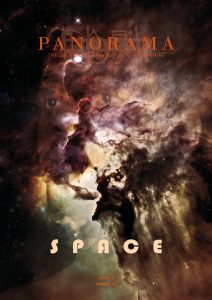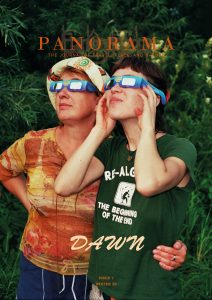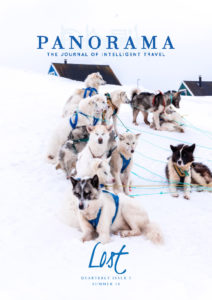It’s not unusual to see animals in captivity, but what does it mean to put their wildness on display? The author contemplates a surprising connection with caged animals when they turn their gaze back on her.
To tell you that the Parisian apartment I shared with my family for a year was cramped would be an injustice to small things. Our apartment was so tight that when we arrived with our bulky bags and ample wardrobes and avid American attitudes, we couldn’t find space for all our stuff. The culture shock was brisk and pitiless as we shrunk to size and learned to edge carefully into tiny rooms. One day, however, when my five-year-old son was ill, I couldn’t stand those enclosing walls for another moment. I decided to take him to the Jardin des Plantes nearby. James wasn’t terribly unwell so a walk around the city zoo seemed like gentle medicine for us both.
There’s something hidden and jewel-like about the Jardin des Plantes. Chances are, if you’re not specifically headed there—just ambling along the Left Bank, say, and admiring the barges on the Seine, or the cartoonish police vans, or the dappled shade along the boulevard — you are not thinking of beasts until a sudden stink of wildness wafts over the 12-foot wall. Then perhaps you recall you’re alongside a menagerie, arboretum, and natural history museum rolled into one. And perhaps you remember, too, that the Parisian elite once ate all the animals during a long-ago war. You can even find their fancy menus online. For me, though, that ripe smell loops me back to my son, particularly his anxiety that the park’s annual festival of lights would ruin the animals’ sleep. This was their house, he reasoned, and humans were using it to throw parties. How rude.
James was eager to visit the snakes. It was gloomy and quiet inside the snakehouse and we padded past the glass screens in a hush. In the far corner, we stopped to examine a black viper. I’d love to give you a scientific breakdown of its genus, markings, and behaviour; to impress you with my snakey knowledge. But I can’t do that. All I can tell you is that it was probably big and venomous, else why did my five-year-old linger?
James and I studied the creature. It was coiled and still and most of its body was hidden by a rock. But as we made to leave, it suddenly flicked into action, sliding its curves around the structures in its box and raising its head at the glass panel between it and James’ face. It seemed to study him. Its fangs jutted toward him as if it had something to say. Then it began to beat the glass with its tongue, shaking its impressive fork. Perhaps a herpetologist would say this behavior was a territorial mark, an act of aggression, or meaningless because the glass was a one-way mirror, etc. But to my eyes, the snake seemed to be trying to communicate. It channelled something insistent and raw, and my child had been the recipient.
We went to the orangutans. These great creatures both thrill and repulse me with their uncanny resemblance to humans. I can almost trace in the apes’ faces the features of people I know. James and I stood next to the glass and watched our russet cousins climb ropes and swing in a tyre and chase each other in a slo-mo lope. As we got ready to leave, James drew closer to the glass for one last look. The mother orangutan drew closer to the glass, too, until just a hand’s breadth separated them. She reached towards James and with a leathery forefinger tapped the glass. She tapped again and stared at James as he stared at her, a look of pleasure or amusement or benign curiosity washing across her face. There must have been something about James that marked him out from all the other kids behind the glass — the illness that calmed him? his watchful stare? his own boyish rawness? For the second time that morning, James had been chosen by an animal turning its gaze back on him.
*****
As the climate crisis forces me to think about our place in the natural world — what we’ve done to it and what we might do yet — I’m having increasingly uncomfortable thoughts about my species. Why, for example, were those animals in those too-small cages in Paris when, like all living things, surely they deserved the dignity and privacy of home? Signs at the Jardin des Plantes tell how endangered each animal’s native territories are. The redder their signs, the better it must be that this exotic beast is in Paris. The moral weight must fall in favour of captivity then, if the alternative is extinction. But a thought niggles. If this is so, why then should they be displayed like meringues in a patisserie window? When I marvelled at the orangutans, did my human gaze mean I’d prevented its extinction? Probably not. If you followed the money I spent on admission to the zoo, I bet it ended somewhere in local administration, not in habitat conservation far from France.
The truth was that I had gazed at the apes because it was a fun thing to do with my son. It was a chance for me to escape my own cramped Parisian quarters. When the matriarch knocked on the glass, it was as if she had knocked on my conscience, too. She and I both knew she was displayed like that so I might be entertained. I felt unsettled and honestly, a little bit sick.
*****
I’ve had that sickish feeling before. Years ago in Antwerp, I passed briefly through the Red Light District on the way to dinner. I wheeled my bike slowly down Schippersstraat and inspected the women’s faces, bodies, and alluring poses; the special services they provided; and the way they flicked their hair at the young men who passed in growling, horny herds. Occasionally the sex workers looked at me, too, and they gave me the hard face of the shopkeeper who knows you’re only browsing. When our eyes locked, I had that unsettled feeling: not because they were selling sex, but because I wasn’t buying. Those traders were in their display cases for a transactional purpose, and we both knew my eyes had feasted on their wares for free. I had exploited them, our eyes said, and so I scuttled from their district, ashamed.
But why should I feel the same way about a sex worker and an ape? What do they have in common? After all, one would live the remainder of her life in her display case while the other was free to leave after her shift. One had no say about being on show, while the other (I hope) was there as a rational economic choice. One was only an animal, whereas the other was my conceptual sister-in-arms. Yet when those females reversed their gaze, it was I whom they put on display. They exposed me.
*****
I grew up in Zimbabwe. For someone raised in most Westerner’s idea of ‘wilderness’, I saw an awful lot of animals in cages. It was quite normal, for example, to keep a caged parakeet inside your home, despite the flocks of vividly wild birds in the trees outside. For weekend entertainment, we would visit the Larvon Bird Gardens, where unusual birds flitted behind bars; the Lion and Cheetah Park, where big cats ranged in semi-wild enclosures; or the Snake Park, where I recall serpents writhing around in a pit.
It’s funny to think we paid to see the same animals we might see for free in the bushveld outside our town. But maybe it’s not so funny when you think about what my forebears had done to the land. European settlers had forced everything into an enclosure. Symbolically, they had defanged the snake, caged the lion, and clipped the wings of the free creatures that vitalized Africa in its rawest form. But here my colonial mindset corrects me: of course, you would transform something dangerous into an object of curiosity or profit if you could. If you failed to manage the wilderness, it would manage you. You’d be penga not to gate it.
I was in Zimbabwe recently and stayed at a guesthouse near my parents’ home. This guesthouse was especially lovely and exemplified the lush tranquility of the Harare of my childhood. Its gorgeous garden was dotted with shady groves for tea drinking or book reading, and reminded me why people come to my homeland and think they’ve found the Garden of Eden. But tucked into the palms beside the swimming pool was a cage, and inside the cage was a monkey. It was a vervet monkey, a small grey primate whose mischievous antics — mostly in the realm of petty theft — are a delight to observe. Like all monkeys, vervets are intensely social creatures. But this poor fellow at the guesthouse lived alone.
My family and I were not happy to have a prisoner at our vacation home, pressed into the backdrop like a cursed jewel. His dark eyes followed us as we moved from our lounge chair to the breakfast table to the pool, and even when he was fed the leftovers of the guests’ breakfast, he fixed us with a gaze as unfathomable as it was unsettling. The monkey swung through cycles of intense curiosity about us followed by long periods of lassitude where he’d hunch in the corner with his face to the wall. Occasionally, he’d bash his head against the fence. When that happened, the host warned us to keep away.
As the token Zimbabwean, my children turned to me to explain the monkey’s existence inside the cage. But I realised I couldn’t explain the monkey to them unless I explained my childhood, the whole story of my country, and maybe the story of humanity, too. I considered starting with Adam and Eve. Our culture has long prized dominion over nature, I would start, but the children’s eyes would quickly glaze, so why start there? My thoughts flicked to the garden bench whose armrests were made from a pair of wagon-wheels that had brought the pioneers into Southern Africa. Start there? Or with the politics of the guesthouse owner who assured us his monkey would live longer because of the cage. I gave up. There’s no way to explain arbitrary captivity to children. They feel injustice in their guts, and to use pretty words to cover it up would be a further insult against the monkey. Instead, the children and I indulged in the fantasy of releasing him to his wild brothers the moment our host looked away. The monkey would perish quickly, we knew, but maybe also with privacy and dignity — finally free from our gaze.
*****
In thinking about those eyes inside their cages, I’m in a newly unstable place. If I can communicate with a snake or an ape, then what should I do if I decide these more-than-humans are my equals? My culture depends on me not knowing anything about the creatures that feed, protect and entertain me. But what if I started to look?
I decided to try. My family sometimes cares for our friend’s dog, a Rhodesian Ridgeback so striking that strangers stop us on the street to praise him. When I’m at my desk, Tex lies in the rhomboid of sunlight falling on the rug behind my chair. As he shifts with the shifting sun, I can almost feel his body absorbing the light. Curious if I could more deeply inhabit the texture of his world, I lay beside him on the rug. I imagined the stiffness of the ground as support rather than hardship, and noticed how different the carpet felt now that its fibres were latticed across my cheek. With my ear pressed to the floor, I heard my house creaking and sighing. Surprise! It has an auditory life of its own, one I’d never have known if I hadn’t tried to be a dog. Gradually, I stilled my breathing until it matched Tex’s. Then, to the secret murmurs of my house and the gentle bake of the sun, I fell asleep. Later, when I awoke, I was surprised to find Tex’s face close to mine. He was studying me and for a moment, we beheld each other in a web of context that felt no less shared because of the space between us. Then, with an unspoken agreement, we blinked and turned away, each returning to the sensory enigmas of our own animal gaze.











